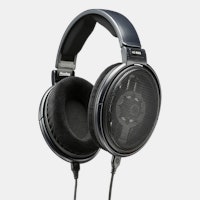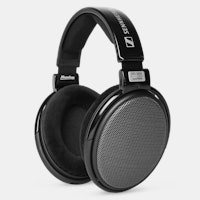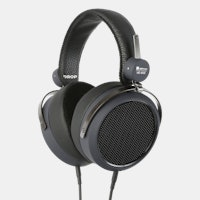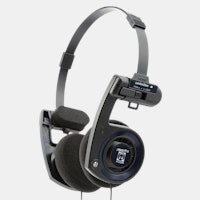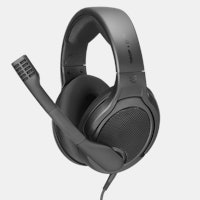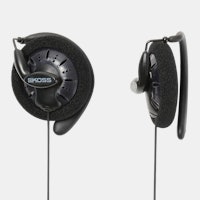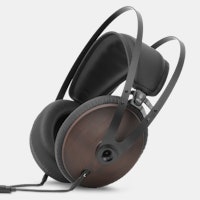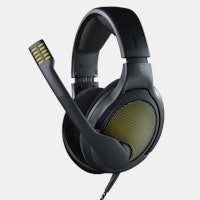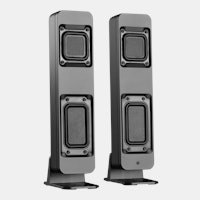Click to view our Accessibility Statement or contact us with accessibility-related questions












Showing 1 of 317 reviews about:

Massdrop x Koss ESP/95X Electrostatic System
joe.b.thornton.jr
12
Jul 4, 2019
checkVerified Buyer
Sonically pure.
RME-ADI-2 DAC feeding the Koss E/90X. To my ears, the ESP/95X in most ways out perform my Sennheiser HD650s, HD800s, Audeze LCD 2.2s, and LCD XCs. The ESP/95X is in a class by itself. Bring on the Sennheiser HE60s. I'd love to see how they measure up.
(Edited)
Recommends this product? Yes

Mohannad13
94
Sep 15, 2019
joe.b.thornton.jrCan you specify the things that 95x makes it better than lcd2 and 650 ?

Nottagorilla
65
Nov 20, 2019
Mohannad13The MassDrop/Koss is Electrostatic. Your other headphones are "dynamic" types, using fine wire voice coils glued to a small loudspeaker-type cone made of a relatively-thin, somewhat hard plastic material. Magnets provide the "centering" forces that the electromagnetic field generated by power applied to the voice coil works against. The voice coil in most dynamic headphones are mounted perpendicular to the diaphragm "cone", so the forces applied to that diaphragm amounts to a tiny ring in its center. The LCD-2 may be a "planar" (flat construction) dynamic driver, as opposed to the (Sennheiser?) 650 which is a cone like I described. A planar diaphragm has its voice coil mounted in PARALLEL with the cone surface, so more wire contacts the diaphragm. This would APPEAR to distribute the driving force more equally over the diaphragm surface, but in practice the difference is rather small (ratio of amount of wire in contact with total diaphragm surface area). What DOES happen is efficiency goes way down versus cone/round voice coil construction due to the inability to concentrate (focus...) the magnetic field over the entire voice coil with anything like the same intensity for a given magnet weight...
The best planars do manage to overcome these problems well enough to outperform MOST "conventional" cone drivers with circular voice coils. Other problems with dynamic drivers is that at certain frequencies the poor coupling of voice coil force to the diaphragm results in random & unwanted (out of phase) vibration of PART of the diaphragm; usually as frequency rises, only the parts of the diaphragm closest to the voice coil wires moves properly in-sync with it. At a high enough frequency, the difference in the weight of the voice coil wires to the overall weight of the diaphragm itself causes them to start to respond to the music signal differently. Both rolloff of frequency response & distortion occurs.
By contrast, the Electrostatic diaphragm is energised not by a magnet system for its "centering" force, but by high-voltage (static electricity). This force is much weaker than a magnet's force, but this disadvantage is largely compensated for by 2 big advantages. The first is that the diaphragm doesn't have voice coil wire glued to it, it has no voice coil at all!
So the diaphragm is MUCH lighter, but things STILL get even better!
Because the dynamic diaphragm has to hold all the voice coil wire firmly onto it, it has to be much stronger physically than a diaphragm for Electrostatic actuation. The Electrostatic diaphragm DOES have to hold an "analog" to a voice coil for driving purposes, but this is just the finest coating or even "impregnation" of a (barely) conductive coating (paint).
So the diaphragm in an electrostatic driver is a mere fraction of the weight (and thickness) of a dynamic one.
The Electrostatic diaphragm sits in between two perforated (so the sound will pass through it) metal plates. The diaphragm is COMPLETELY driven over its entire area by the Electrostatic field created by the high driving & charging voltages. Despite the holes in the outer plates ("stators"), the high voltage creates a uniformity of force field utterly unmatched by any known conventional magnet technology used in dynamic headphones.
The only problems are:
1) Electrostatic forces are much weaker than magnetic ones in practical ("real world") audio transducer applications.
This requires a larger than normal (dynamic) diaphragm placed very close to the source of Electrostatic force (the stators). Because the Electrostatic diaphragm is much more limited in its "available" movement, it has to be much larger to play at the same volume.
So they mostly don't!
Dynamic headphones are far more rugged & will typically play alot louder.
2) Because Electrostatic forces are created by high voltages, typical audio amplifiers can't create anywhere enough. Electrostatic transducers typically need ONE HUNDRED TIMES more voltage to play at a given volume than dynamic drivers do!
So you need a "special" high-voltage amplifier; or, you need step-up transformers to multiply your typical amplifier voltages up to the required level.
The MassDrop/Koss ESP/95X uses a special amplifier, supplied.
As a result, the sound of the special amplifier cannot be separated from the sound of the headphones. Also, Koss uses their own proprietary connectors, despite ELECTRICAL interchangeability with Stax "Pro"-generation headphones. The Stax connector has become, over many years, the "de facto" standard for Electrostatic headphones. Problem is, the MassDrop/Koss is a 25 year-old design, so it predates this evolution in the connector standard. But you can purchase an aftermarket adapter for $150 to make the 95X work with a Stax special amplifier.
Not that you'd be advised to, as the Stax amps are both very expensive & rather shitty sounding compared to the supplied E90 amplifier!
At the end of the day, the reason you would ever want to put up with a fussier, far less rugged technology that doesn't play as loud & needs it's own special amplifier is very simple:
THE SOUND.
Electrostatic transducers typically produce ONE HUNDREDTH the distortion of typical dynamic headphones, and STILL produce only ONE-TENTH the distortion of THE very best dynamic headphones (Focal Utopia, HiFiMan 1000).
Frequency response is also FAR & AWAY much, much smoother & flatter than ANY dynamic type headphones (but they have to be "open back" types to achieve this, but this is true of open-back vs. closed-back design IN GENERAL). But because the best headphones need to be "open-back" for flat frequency response, studio headphones are mostly ALOT SHITTIER & don't include Electrostatic types!
Compared to the other INFERIOR TECHNOLOGY dynamic types, Electrostatic headphones have MUCH clearer & more detailed sound, a MUCH more natural tone due to the flat frequency response, & a much "faster" yet also much "sweeter/liquid" tone than other headphone types.

Mohannad13
94
Nov 21, 2019
NottagorillaYou reply is fantastic many thanks for that but i think you forgot one downside for the electrostatic and it's the vulnerability for humidity and dust .
I have read some comments on reddit says that e stat is very weak against dust.
Do you agree with that ?
And they say that the 95x got shouty mids more than the 650 which makes me thank about it more

Nottagorilla
65
Nov 26, 2019
Mohannad13Electrostatic transducers act like negative-ion generators; high voltages do attract opposite charged dust & dirt particles. But all commercial Electrostatics have a "workaround". They either insulate the metal stator surfaces on either side of the diaphragm (all high quality Electrostatic transducers use a push-pull configuration, so this "sandwich" construction is typical), or they enclose the entire works in a sealed "envelope".
Stax & Koss headphones, & QUAD loudspeakers, are enclosed in sealed dust-proof enclosures. As long as that seal is not physically damaged with a sharp object penetrating it, dust never gets in. I have a 45 yr. old pair of Stax SRX-III & a 50 yr. old pair of Koss ESP/6 headphones that both still work PERFECTLY! And I have QUAD Electrostatic loudspeakers that are older than that in similar condition!!
Electrostatic technology is very reliable IF it is designed & built properly. Problem is, many companies have fucked up spectacularly, including QUAD on their post-1980 speaker models. But for headphones, Koss & Stax are trustworthy. Other brands like HiFiMan & Mr. Speakers, we'll see...
As for the 95x having a "shouty" midrange, this is hilarious! The 95x has THE BEST midrange (& bass) of ANY transducer EVER MADE, every bit the equal of Stax 009's. There is NOTHING with lower distortion, more resolution, or with a flatter frequency response/truest tone & timbre. Sennheiser 650's? This is GARBAGE by comparison, even if they sound okay in isolation. Frequency response is a total mess by comparison, distortion is 10-100 times higher at any given frequency at any SPL under 100db. HiFiMan & Audeze make better headphones than Sennheiser. I think the person who made that comment needs to upgrade their 128 (or less) kb/s MP3 player, or get a new flip phone...
PRODUCTS YOU MAY LIKE
Trending Posts in Audiophile

SsButerbal
Ringing in PC38X's
I recently got this headset, and wow is it good. My only issue is when certain people talk on discord, I can hear a really high pitched ringing. I fiddled with a bunch of settings, computer audio and discord, and nothing seems to solve the issue. It is primarily if not all in my right ear only. Is there something wrong with my headset, or was that ringing always there I can just hear it cause the headset is THAT good? I haven't had any issues with any other application, though I have yet to test if I can hear the ringing on a different version of discord, say on my xbox instead of my pc. Only other issue I've had is occasional static, but I can't tell if it's from the headset or the show/game/etc.
Apr 24, 2024
itsamepe
Sennheiser PC37X randomly goes bad after disconnecting the cable ?
Greetings, Yesterday I was using my headset like normal with my macbook, just listening to music and on a call with people like usual, and the headset was perfectly fine. The stock wire that came with the headset is extremely long and yesterday it annoyed me very much that it kept getting tangled with itself, so I decided to see if the cable is replaceable. I pulled out the cable from the headset and saw the adapter, and looked online for a replacement. Upon plugging it back in, the audio sounded extremely muffled and washed out. Im not sure what I did wrong to make it mess up like that as I've always taken good care of it, ive had it for about 2 years and its always just been chilling on my desk, but anywho I thought the cable just went bad and ordered a replacement. The replacement came, and the issue is still persistant, so I am not sure what the issue is I've tried multiple different headsets and the issue is not with the port, and I also tried it with my windows laptop and...
Apr 23, 2024

MrChiSox
Big changes coming to my tiny little music room, I've recently purchased a new stack. Currently figuring out where to locate it all and ordering up the necessary cables, it won't be too long before I'm up and running. I am now the proud owner of a brand new stack. It's a European brand called Earmen. Amp, DAC, Streamer & Linear Power Supply. It won't be long!
https://www.youtube.com/watch?v=MB15yM4UptQ
Apr 23, 2024

Briankan
Recommendation for my next headphone set? I have Koss 95x
Hey all, What would you recommend I get next and why? I have Koss ESP-95x electrostatic massdrop headphones. These are my first and only audiophile set. I love them. I think my only real requirements is $500 or less for the headphones and that they have a little more low end. I don’t need thump but these are really light on lows…but the experience is still awesome. Also any recommendations on an amp? I only have my electrostatic thingy. I am using the Topping D50 DAC. thx!!
Apr 22, 2024

Simthaniel
Rigs
Modded headphones with qudelix at the core
When I received the Qudelix 5K, I had already modified a pair of Superlux HD-681 headphones. I previously soldered my own balanced connections to the drivers, providing multiple ways to connect and...
Apr 14, 2024

brothamike
A decent set of IEMs
I am in the midst of a 300 hour burn-in but, I will say I am enjoying how this set sounds so far. Before I received these which was btw late by a few weeks, I purchased a Sony/Kimber Kable MMCX...
Apr 12, 2024
merrick97
Should I exchange the PC38X for better headphones?
I bought the PC38X headphones FOR GAMING and they are great, but I have NO use for a Microphone since I don't do competitive gaming and I was wondering if there were better headphone options at a similar price without a headphone, where (presumably) more of the cost was put into making it sound better. I also find that my PC38X don't get quite as loud as I would like and I was wondering if a cheap amp like the iFi Go link would draw a little more volume out of my phones. https://www.amazon.com/dp/B0BN6MM822?psc=1&ref=ppx_yo2ov_dt_b_product_details I went with the PC38X since it was considered the best bang for buck headphones. I care most about using spatial apps like DOlby Atmos and DTS Headphone:X. Suggestions are welcome.
Apr 11, 2024
